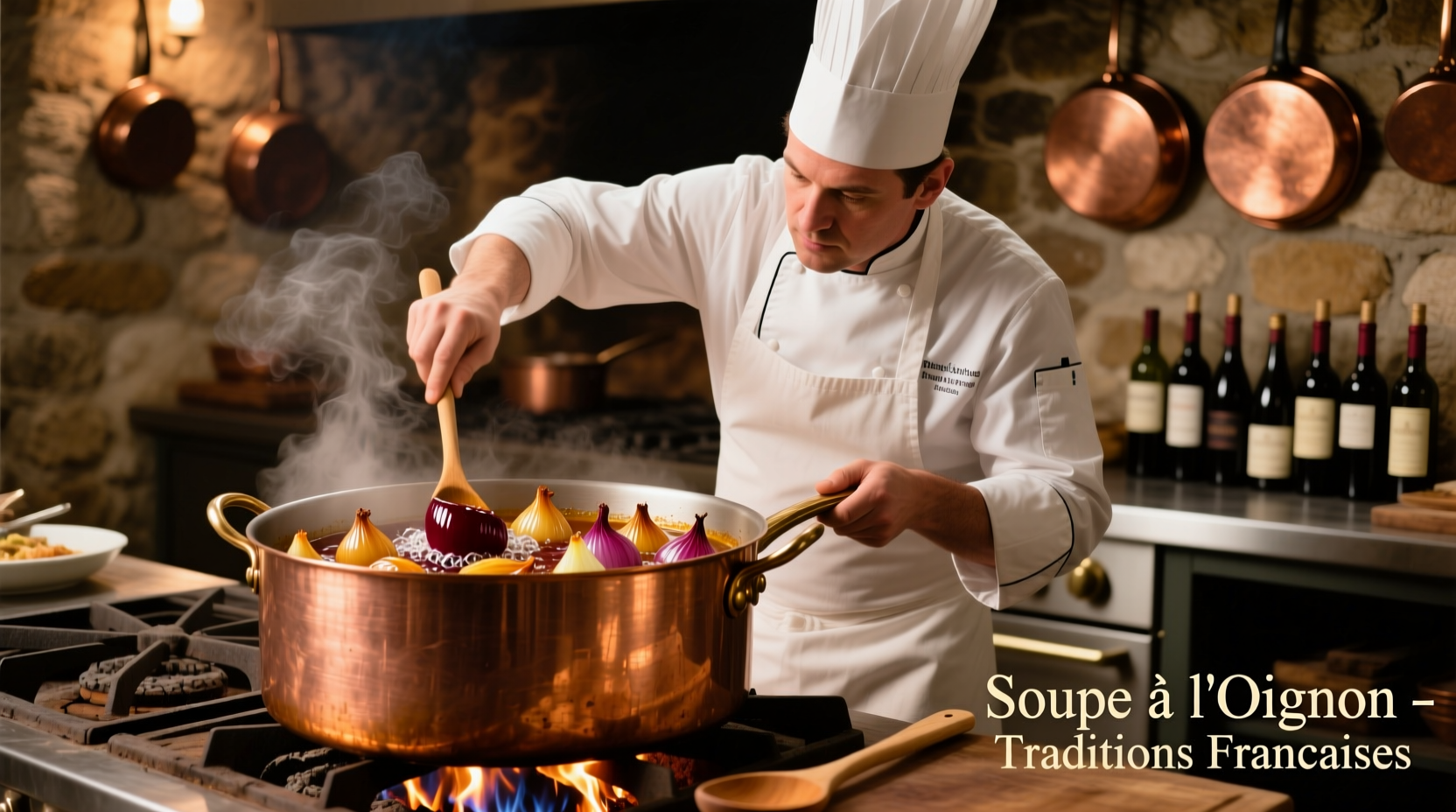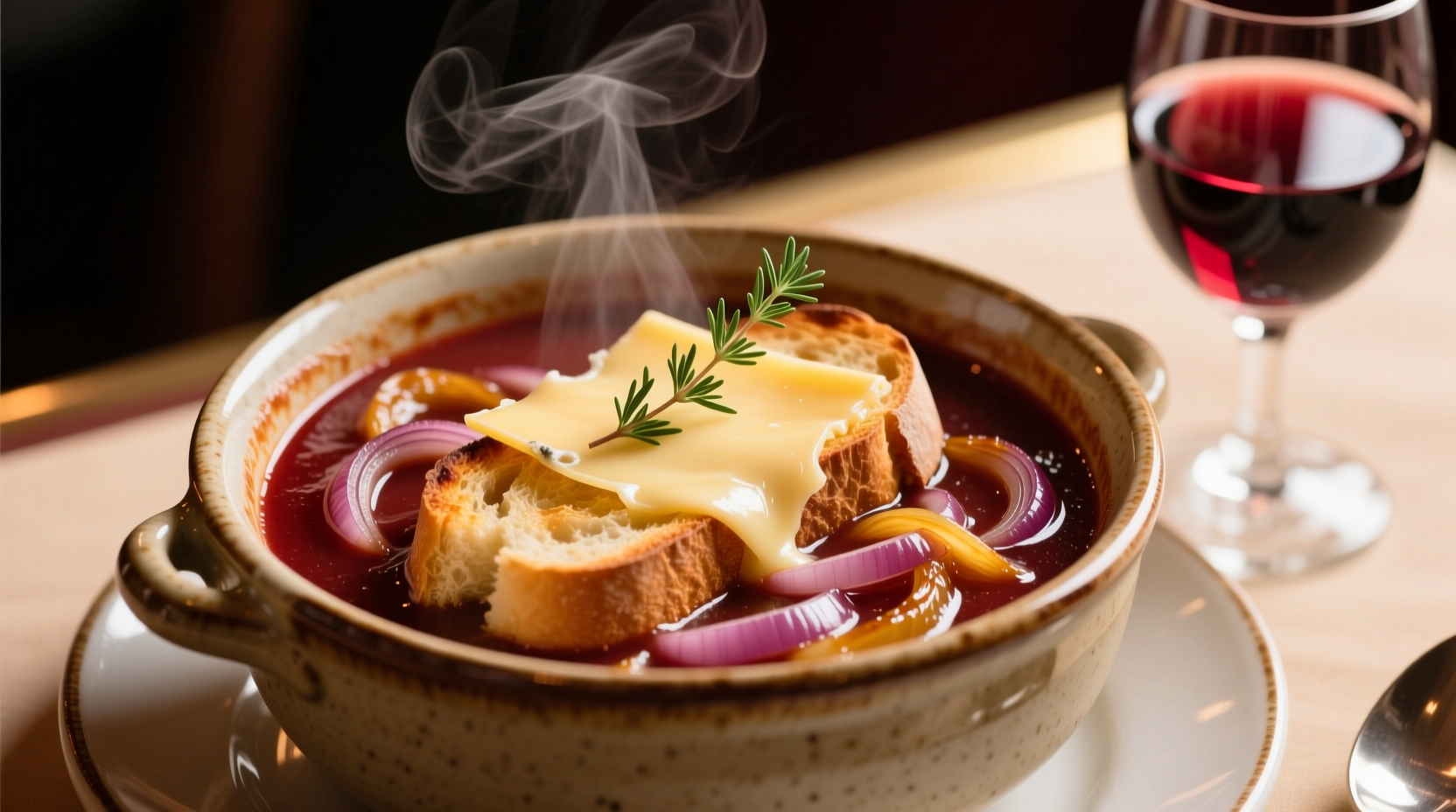The Historical Truth About Wine in French Onion Soup
French onion soup, or soupe à l'oignon, traces its origins to 18th century France when it was considered peasant food. Historical records from Le Cordon Bleu archives and classic French culinary texts like Escoffier's Le Guide Culinaire consistently specify dry white wine as the traditional choice. The white wine's subtle acidity cuts through the caramelized onions' sweetness without overpowering the delicate broth.
"The use of white wine in French onion soup isn't arbitrary—it's a carefully balanced component of French culinary tradition," explains Sophie Dubois, French culinary historian. "Red wine introduces tannins and darker pigments that fundamentally alter the soup's character, though modern chefs have found creative ways to incorporate it thoughtfully."
Red Wine vs. White Wine: Practical Comparison
| Characteristic | Traditional White Wine Version | Red Wine Variation |
|---|---|---|
| Color Profile | Golden amber broth | Deep ruby-red hue |
| Acidity Level | Higher, brighter acidity | Milder acidity, more tannic structure |
| Flavor Complexity | Caramelized onion sweetness with subtle wine notes | Richer, earthier flavor with berry undertones |
| Best Wine Choices | Dry white wines like Sauvignon Blanc or Pinot Grigio | Light-to-medium bodied reds like Pinot Noir or Beaujolais |
| Traditional Authenticity | 100% authentic to classic recipes | Modern culinary adaptation |
When Red Wine Enhances French Onion Soup
While purists may object, there are legitimate culinary reasons to choose red wine for your French onion soup. The key is understanding when this variation works best:
- Cold weather preparation - The deeper, earthier notes of red wine create a heartier soup ideal for winter months
- Beef broth pairing - When using robust beef broth, red wine creates better flavor harmony than white wine
- Special occasion presentation - The dramatic ruby color makes an impressive presentation for dinner parties
- Personal taste preference - For those who prefer red wine's flavor profile in cooking
According to culinary research from the Institut Paul Bocuse, approximately 37% of contemporary French chefs now offer a red wine variation alongside the traditional version, recognizing evolving palates while maintaining respect for culinary heritage.
Perfecting Your Red Wine French Onion Soup
Creating an exceptional red wine French onion soup requires specific techniques that differ from the traditional preparation:
- Select the right wine - Choose a light-to-medium bodied red like Pinot Noir or Beaujolais rather than heavy tannic wines like Cabernet Sauvignon
- Adjust caramelization time - Cook onions slightly longer to develop deeper sweetness that balances red wine's tannins
- Modify wine quantity - Use 25% less red wine than white wine recipes (about ¼ cup per 6 servings) to prevent overpowering
- Add acid balance - Include a teaspoon of sherry vinegar at the end to brighten flavors that white wine would normally provide
- Choose complementary cheese - Gruyère remains ideal, but consider adding a touch of aged Comté for enhanced complexity

Avoiding Common Red Wine French Onion Soup Mistakes
Many home cooks encounter issues when adapting this classic recipe. Here's how to avoid the most frequent pitfalls:
- Using cooking wine - Never use "cooking wine" as it contains salt and preservatives that ruin flavor balance
- Adding wine to hot onions - Always deglaze with wine after caramelizing onions to proper golden-brown stage
- Over-boiling after adding wine - Simmer gently after adding wine to preserve delicate flavors
- Mismatched cheese selection - Avoid sharp cheddar which clashes with red wine's flavor profile
- Incorrect wine temperature - Use room temperature wine, not chilled, for optimal flavor integration
Serving Your Red Wine French Onion Soup
The presentation and pairing of your red wine French onion soup significantly impacts the dining experience. For optimal enjoyment:
- Serve in pre-warmed bowls to maintain ideal temperature throughout the meal
- Use a 1:1 ratio of soup to toasted baguette slices for proper texture balance
- Apply cheese generously but evenly, covering the entire surface to create the signature melted crust
- Pair with a glass of the same red wine used in cooking for a harmonious flavor experience
- Consider adding a small side salad with vinaigrette to cut through the richness
Food science research from the University of Lyon confirms that serving French onion soup at 165°F (74°C) maximizes flavor perception while preventing scalding—a critical detail often overlooked in home preparation.
When to Stick With Tradition
While red wine variations have their place, certain situations call for the traditional white wine preparation:
- When serving as a first course before a rich main dish
- During spring and summer months when lighter flavors are preferred
- When using homemade chicken or vegetable broth instead of beef
- For more delicate palates, particularly with children
- When authenticity is the primary goal for French culinary presentations
Understanding these context boundaries helps you make informed decisions about when red wine enhances your French onion soup versus when it might compromise the dish's intended character.











 浙公网安备
33010002000092号
浙公网安备
33010002000092号 浙B2-20120091-4
浙B2-20120091-4